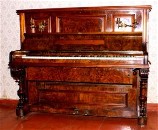
 |
 |
 |

I don't work on electronic organs anymore, but I do still work on reed organs that you pump with your feet. Typically reed organs need to have their bellows recovered, and sometimes the pallet valves need to be recovered as well. Prices usually start at around $750, but most often it ends up being around $2000 for a basic reed organ refurbishment. Tuning ......... should be done at least once a year in this area, however manufacturers suggest pianos be tuned twice a year. The worst month to do this is January. That's the month we typically have the coldest weather in this area. That translates into the heat being on the most, drying out the house. The lack of humidity changes the dimensions in the piano enough to affect the tuning. Then, in the following months, the humidity goes back up and the piano sounds a little better, but not quite as good as it did prior to January. So, if you tuned it in January while it was way out of tune because of the lack of humidity, then in February it will sound just as bad as it did prior to the tuning in January. Most people have their pianos tuned in December, when they have guests for the holidays. Be sure to call well ahead of time to get the appointment date you desire. The best time to tune a piano is after the heat comes on in the fall. After moving a piano, be sure to let it settle for a few weeks to a month or so before tuning it. The greater the distance you move a piano, the more time it needs to settle. Pitch Raises ............. are done on pianos that have been neglected for years. Decades of humidity and temperature changes make pianos go flat in pitch. The structure of a piano holds 26 tons of stress, so a sizable change in overall stress is to be expected and is compensated with repeated work on the tuning pins. Turning a tuning pin changes the string's pitch. It doesn't take much movement for the ear to hear the difference, and numerous passes are needed to get the entire structure of the piano to accept the proper stress. Repairs ......... are many and varied: debris getting in the way of the mechanism to structural failures. The internal mechanism is complex and often needs repairs. The most accurate quotes for repairs are done on location after I've had a chance to determine the best possible repair. Regulation ......... should be done periodically. A piano action has over 30 adjustments per key. When all are optimally adjusted, the piano is a responsive and a pleasure to play. After years of playing, the felt pads and the leather parts become compacted and worn, so therefore they have a different shape than when they were new. There are adjustments to compensate for these changes. Making these adjustments is called "regulation". The fee for this varies. The longer a piano has gone without a proper regulation, the more it costs. |
||||||||||||||

Hammers ........ get flat spots with usage. The hammer hits the string in the exact same place every time, and after a while develops a flat spot with string cuts. If the string cuts are deep enough the tone produced is more of a percussive knock than a musical tone. The hammers at the top of the scale are covered with only about a quarter inch of felt so that's where the string cuts sometimes reach the wooden core of the hammer. Reshaping the hammer may restore the tone of the hammer for a while, but eventually they will have to be replaced. The cost of new hammers varies from one piano to the next, depending on wheather it's a grand or vertical, replacement sources, and how much wear on other parts is present. Dampers ......... become compressed with age and are then less effective in dampening the tone after the note is released. I've seen some old damper felt mushroom out from the wooden damper head to the point that it rubs the note next door. Spilled liquids that have soaked into the damper felt sometimes cause the felt to become hard, producing a sound of it's own when it presses against the string on key release. The cost of replacing dampers or damper felt varies depending on how many need replacement, and the cost of supplies.
| ||||||||||||||